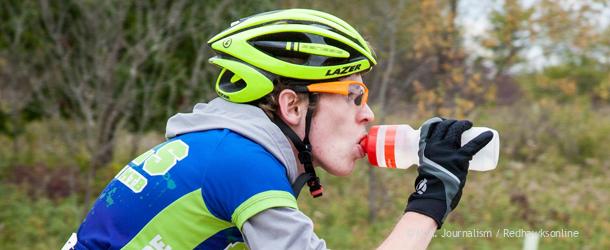Competitive mountain biking inspires life-long fitness in a positive, encouraging community
Sweat drips from under a helmet, falling onto bikers’ gloved hands which are gripping onto the handlebars of their mountain bike. A tree appears ahead and they veer sharply to avoid it, still staying on the path marked out for them. A sharp drop forces tires into the air momentarily, and then just as suddenly, they all slam back onto the rocky terrain. At that moment, the finish line is in sight.
For most, biking may just be a way to get from home to the grocery store or to get in a light workout, but for seniors Zach Newton and Griffin Snow, it is an intense competitive sport.
The idea of competitive mountain bike racing came to fruition in Northern California at Berkeley High School. A math teacher had a desire to start a cycling club for students in his math class and he put together a small mountain biking team. Once the word was out, other high schools around the area started teams as well. They formed the Northern California Bike League. Then in 2009, the sport went national through the organization NICA, or National Interscholastic Cycling Association (NICA). With the help of NICA, 16 states have high school mountain biking teams and by 2020, NICA hopes to make it a national sport with all 50 states involved.
Here in Minnesota there are 43 teams in the Minnesota Mountain Biking High School League, which are either co-ops or high school sanctioned.
“One model is that all the kids are from one high school,” said Gary Sjoquist, advocacy director for Minnesota Mountain Biking High School League. “Then we have what we call a composite team and that’s where we say, ‘okay if you have two or three high school from the same area, you can race as a composite team for two years but eventually we want you to go back and start a team from your own individual high school.'”
Mountain Biking is considered a club sport, not an official high school sport. However, recently riders were made eligible to earn a varsity letter for mountain biking.
“We’re getting closer and closer, said Sjoquist. “But right now we’re not an official high school sport. We’re not under the umbrella of the Minnesota State High School League.”
Newton got involved in the Minnesota State Mountain Biking Series, a summer series with about 10 races over the summer, when he was about 10 years old. Then when the High School League was started 4 years ago, Newton joined that. Two years later, Snow joined. The two of them race for the Minneapolis South Side Composite Team, which includes bikers from Prior Lake, Wayzata, Edina, Lakeville, Minneapolis South and Washburn.
“Minnehaha itself doesn’t have a specific team, which is why we were allowed then to join another team outside of school,” said Snow. “We are just as much a part of that team as anybody.”
There are two main practice sites for the composite team Snow and Newton are on. “When we’re [practicing] at Washburn, it’s hill-repeats or some other hard work out for stamina,” said Newton. “The other place we practice is the Greenway and from there [we ride] to Worth Parkway for single track practice.”
Single track, a narrow dirt path that has just enough room between trees for a rider’s handlebars, is the kind of path bikers in this league practice and race on. The season is from September to October and has five races held every other weekend. The first race of the 2014 was at Buck Hill in Burnsville. The last race of the season took place on Oct. 26 in River Falls, WI.
“A typical track will be four to six miles, four to five hundred feet of climbing per lap,” said Sjoquist of the racing courses. “We have uphill starts so that the kids can get kind of spread out before entering the single track and then uphill finishes, again so the kids can spread out so we don’t have 30 kids trying to cross the finish line all at once.”
Snow rides in the second heat of the JV races and Newton races Varsity. Races take up the majority of a Saturday, involving warming up and awards and encouraging teammates.
With such little room on the course, as well as obstacles like trees and rocks, the rocky terrain of Mountain Biking races come with a long list of safety precautions. There are many course marshals that are present on the course at all times, riding around to make sure all riders are safe, as well as a sweeper, who rides behind the last biker. An ambulance is always on duty at the races, and at the bigger ones, there is even a hospital helicopter. For individual safety, helmets are required as well as riding style rules such as keeping both wheels on the ground and staying seated on the bicycle at all times.
Sjoquist encourages biking as a life-long sport along with a sense of ‘no matter the speed, strength level or experience of anybody on the team, they’re still valuable to the team.’
“In traditional sports there are very few who are actually out on the field for the game, a lot of kids ride the bench,” said Sjoquist. “In this situation, even the kid who is way in the back, just barely finishing, contributes points to their team’s success.”
It’s this feeling of community, self-worth and positivity that keeps high schoolers coming back for more.
“Mountain biking in general is a pretty relaxed community,” said Snow. “It’s fun and really enjoyable to be around all of the positive energy.”

